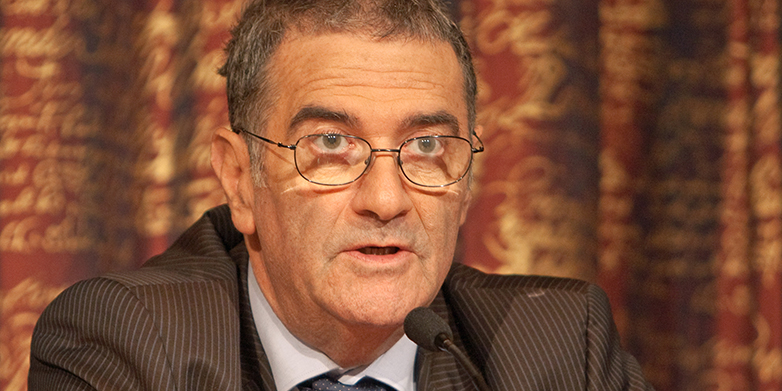Paul Bernays Lectures 2015
Serge Haroche, Collège de France, Paris
Professor Serge Haroche is professor at Collège de France, holding the chair of quantum physics. His main research activities have been in quantum optics and quantum information science. During the seventies he developed new methods for laser spectroscopy. He then moved on to study Rydberg atoms showing that such atoms are well-suited to test quantum decoherence and to realize quantum logic operations necessary for the treatment of quantum information. In 2012 Haroche was awarded the Nobel Prize in physics for his "ground-breaking experimental methods that enable measuring and manipulation of individual quantum systems".
Portrait on ETH News: At the frontier of the quantum world

Programme
Lecture 1: Celebrating the International Year of Light: How the laser has revolutionized physics over the last fifty years
Tuesday, 8 September 2015, 5.00 p.m.
Abstract
The year 2015 has been declared the International Year of Light to celebrate several important discoveries about electromagnetic radiation which have occurred 200, 150, 100 and 50 years ago. This celebration provides an opportunity to reflect on the extraordinary revolutions that the development of lasers have made possible in various fields of physics over the last half-century. Lasers have been used to cool atoms to the lowest temperatures ever achieved, leading to the discovery of new phases of matter with remarkable quantum properties. They have allowed physicists to control and manipulate isolated quantum particles with an exquisite precision, promising applications to quantum information processing. Lasers have also led to the invention of atomic clocks measuring time with an uncertainty of only one second over the age of the Universe, an extraordinary precision opening the way to ultra-precise tests of fundamental laws in physics. Lasers have also been turned into light sources with extreme properties, combining huge power fluxes with ultra-short pulse durations, which has opened the way to the experimental studies of a wide variety of extremely fast phenomena in atomic, molecular and solid state physics. None of these developments were foreseen when the first lasers appeared in the 1960’s, at the time I started my career as a physicist. I will try to convey in this talk the excitement and wonderment of the scientists of my generation who have witnessed the extraordinary achievements in physics that the laser “light fantastic” has brought about.
Lecture 2: Controlling photons in a box and raising Schrödinger cats of light: When thought experiments become real
Wednesday, 9 Sept 2015, 4.30 p.m.
Abstract
In the early days of quantum physics, the fathers of the theory used to imagine "thought experiments" in which they assumed that they were manipulating quantum systems evolving according to the strange and counterintuitive laws which they had just discovered. At that time, they believed that these experiments would remain forever virtual. Technological advances have changed this state of affairs and made possible the actual control and manipulation of isolated quantum particles. Many laboratories around the world are realizing such experiments which constitute a new domain of research at the frontier between physics and information science. Fundamentally, the goal of these studies is to explore the transition between the microscopic world where quantum laws are dominant and our macroscopic environment which appears classical. More practically, physicists are hoping that these experiments will open the way to new technologies exploiting the strange logic of the quantum world to compute, communicate or measure physical quantities better than what was previously conceivable. In Paris, we perform such experiments by juggling with atoms interacting with microwave photons trapped between highly reflecting superconducting mirrors. We have prepared superposition states of radiation analogous to the famous "Schrödinger cat" that the Austrian physicist had imagined to be suspended between life and death and we have studied the decoherence of these states, i.e. the process by which they lose in a short time their strange "quantumness". I will give a simple description of these experiments and compare them to similar studies performed on other systems. Finally, I will try to make a few guesses about the possible applications of these studies.
Lecture 3: Counting and controlling photons non-destructively
Thursday, 10 September 2015, 4.30 p.m.
Abstract
Usually photons are destroyed when they are detected. Photon demolition is however not a fate required by quantum principles. In our Paris Cavity Quantum Electrodynamics experiment which is a modern version of the famous Einstein-Bohr photon box, an atomic clock operating with Rydberg atoms counts non destructively the photons stored in a high Q cavity. This experiment directly reveals the quantum jumps of the electromagnetic field. By implementing quantum feedback methods, radiation states with well-defined photon numbers are prepared and maintained in the cavity for an arbitrary time. These atomic physics experiments are now extended in an expanding domain of condensed matter physics called "Circuit QED", where Rydberg atoms are replaced by artificial atoms made of Josephson junction circuits. Applications to quantum information science of these studies will be discussed.